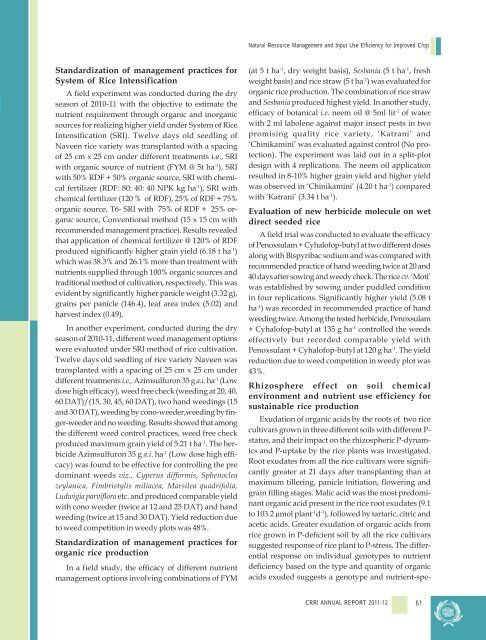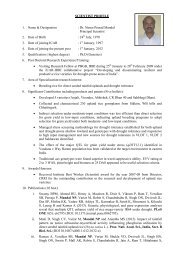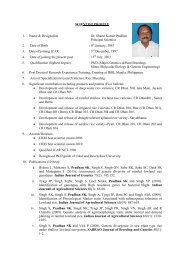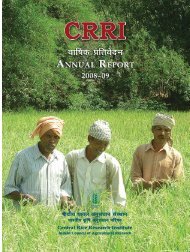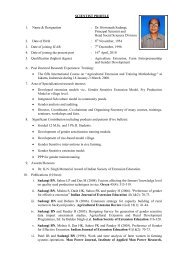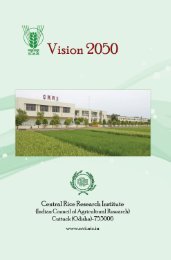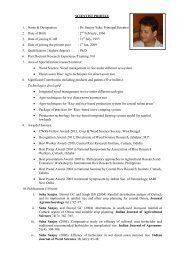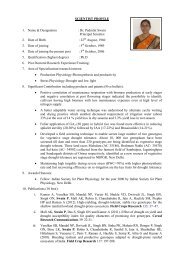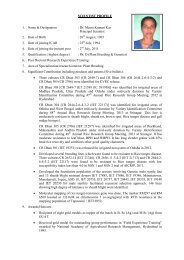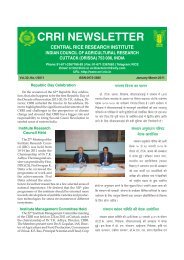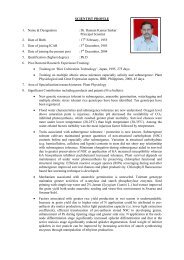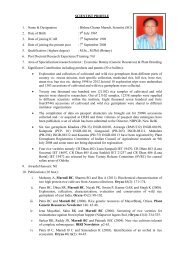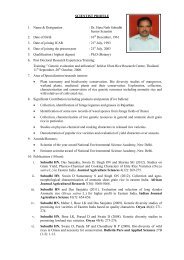Central Rice Research Institute Annual report...2011-12
Central Rice Research Institute Annual report...2011-12
Central Rice Research Institute Annual report...2011-12
You also want an ePaper? Increase the reach of your titles
YUMPU automatically turns print PDFs into web optimized ePapers that Google loves.
Natural Resource Management and Input Use Efficiency for Improved Crop<br />
Standardization of management practices for<br />
System of <strong>Rice</strong> Intensification<br />
A field experiment was conducted during the dry<br />
season of 2010-11 with the objective to estimate the<br />
nutrient requirement through organic and inorganic<br />
sources for realizing higher yield under System of <strong>Rice</strong><br />
Intensification (SRI). Twelve days old seedling of<br />
Naveen rice variety was transplanted with a spacing<br />
of 25 cm x 25 cm under different treatments i.e., SRI<br />
with organic source of nutrient (FYM @ 5t ha -1 ), SRI<br />
with 50% RDF + 50% organic source, SRI with chemical<br />
fertilizer (RDF: 80: 40: 40 NPK kg ha -1 ), SRI with<br />
chemical fertilizer (<strong>12</strong>0 % of RDF), 25% of RDF + 75%<br />
organic source, T6- SRI with 75% of RDF + 25% organic<br />
source, Conventional method (15 x 15 cm with<br />
recommended management practice). Results revealed<br />
that application of chemical fertilizer @ <strong>12</strong>0% of RDF<br />
produced significantly higher grain yield (6.18 t ha -1 )<br />
which was 38.3% and 26.1% more than treatment with<br />
nutrients supplied through 100% organic sources and<br />
traditional method of cultivation, respectively. This was<br />
evident by significantly higher panicle weight (3.32 g),<br />
grains per panicle (146.4), leaf area index (5.02) and<br />
harvest index (0.49).<br />
In another experiment, conducted during the dry<br />
season of 2010-11, different weed management options<br />
were evaluated under SRI method of rice cultivation.<br />
Twelve days old seedling of rice variety Naveen was<br />
transplanted with a spacing of 25 cm x 25 cm under<br />
different treatments i.e., Azimsulfuron 35 g a.i. ha -1 (Low<br />
dose high efficacy), weed free check (weeding at 20, 40,<br />
60 DAT)/(15, 30, 45, 60 DAT), two hand weedings (15<br />
and 30 DAT), weeding by cono-weeder,weeding by finger-weeder<br />
and no weeding. Results showed that among<br />
the different weed control practices, weed free check<br />
produced maximum grain yield of 5.21 t ha -1 . The herbicide<br />
Azimsulfuron 35 g a.i. ha -1 (Low dose high efficacy)<br />
was found to be effective for controlling the pre<br />
dominant weeds viz., Cyperus difformis, Sphenoclea<br />
zeylanica, Fimbristylis miliacea, Marsilea quadrifolia,<br />
Ludwigia parviflora etc. and produced comparable yield<br />
with cono weeder (twice at <strong>12</strong> and 25 DAT) and hand<br />
weeding (twice at 15 and 30 DAT). Yield reduction due<br />
to weed competition in weedy plots was 48%.<br />
Standardization of management practices for<br />
organic rice production<br />
In a field study, the efficacy of different nutrient<br />
management options involving combinations of FYM<br />
(at 5 t ha -1 , dry weight basis), Sesbania (5 t ha -1 , fresh<br />
weight basis) and rice straw (5 t ha -1 ) was evaluated for<br />
organic rice production. The combination of rice straw<br />
and Sesbania produced highest yield. In another study,<br />
efficacy of botanical i.e. neem oil @ 5ml lit -1 of water<br />
with 2 ml labolene against major insect pests in two<br />
promising quality rice variety, ‘Katrani’ and<br />
‘Chinikamini’ was evaluated against control (No protection).<br />
The experiment was laid out in a split-plot<br />
design with 4 replications. The neem oil application<br />
resulted in 8-10% higher grain yield and higher yield<br />
was observed in ‘Chinikamini’ (4.20 t ha -1 ) compared<br />
with ‘Katrani’ (3.34 t ha -1 ).<br />
Evaluation of new herbicide molecule on wet<br />
direct seeded rice<br />
A field trial was conducted to evaluate the efficacy<br />
of Penoxsulam + Cyhalofop-butyl at two different doses<br />
along with Bispyribac sodium and was compared with<br />
recommended practice of hand weeding twice at 20 and<br />
40 days after sowing and weedy check. The rice cv. ‘Moti’<br />
was established by sowing under puddled condition<br />
in four replications. Significantly higher yield (5.08 t<br />
ha -1 ) was recorded in recommended practice of hand<br />
weeding twice. Among the tested herbicide, Penoxsulam<br />
+ Cyhalofop-butyl at 135 g ha -1 controlled the weeds<br />
effectively but recorded comparable yield with<br />
Penoxsulam + Cyhalofop-butyl at <strong>12</strong>0 g ha -1 . The yield<br />
reduction due to weed competition in weedy plot was<br />
43%.<br />
Rhizosphere effect on soil chemical<br />
environment and nutrient use efficiency for<br />
sustainable rice production<br />
Exudation of organic acids by the roots of two rice<br />
cultivars grown in three different soils with different P-<br />
status, and their impact on the rhizospheric P-dynamics<br />
and P-uptake by the rice plants was investigated.<br />
Root exudates from all the rice cultivars were significantly<br />
greater at 21 days after transplanting than at<br />
maximum tillering, panicle initiation, flowering and<br />
grain filling stages. Malic acid was the most predominant<br />
organic acid present in the rice root exudates (9.1<br />
to 103.2 mol plant -1 d -1 ), followed by tartaric, citric and<br />
acetic acids. Greater exudation of organic acids from<br />
rice grown in P-deficient soil by all the rice cultivars<br />
suggested response of rice plant to P-stress. The differential<br />
response on individual genotypes to nutrient<br />
deficiency based on the type and quantity of organic<br />
acids exuded suggests a genotype and nutrient-spe-<br />
CRRI ANNUAL REPORT 2011-<strong>12</strong><br />
61


